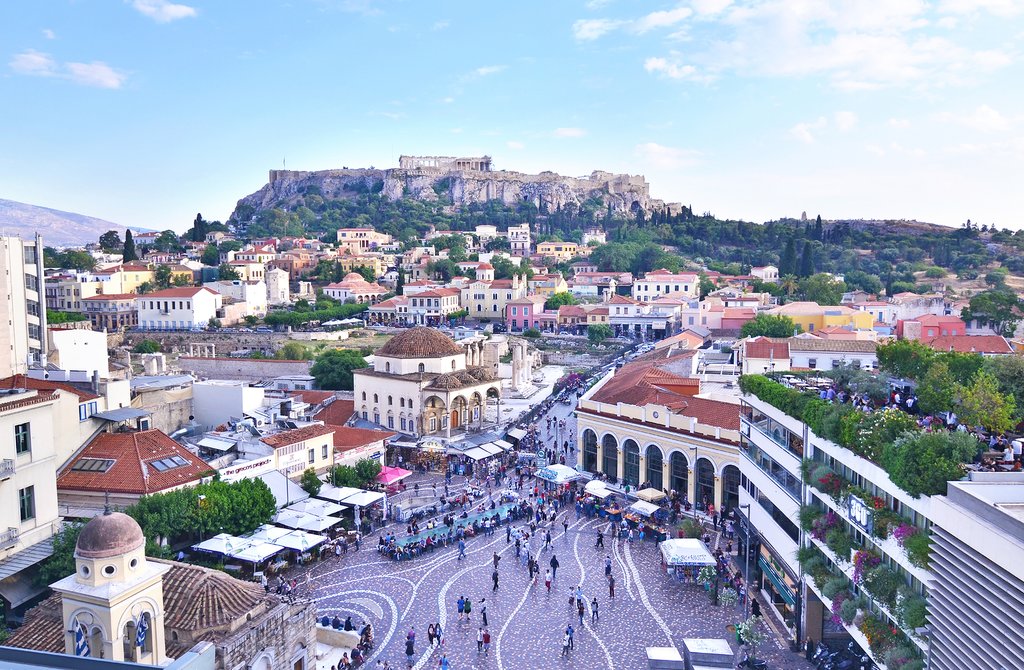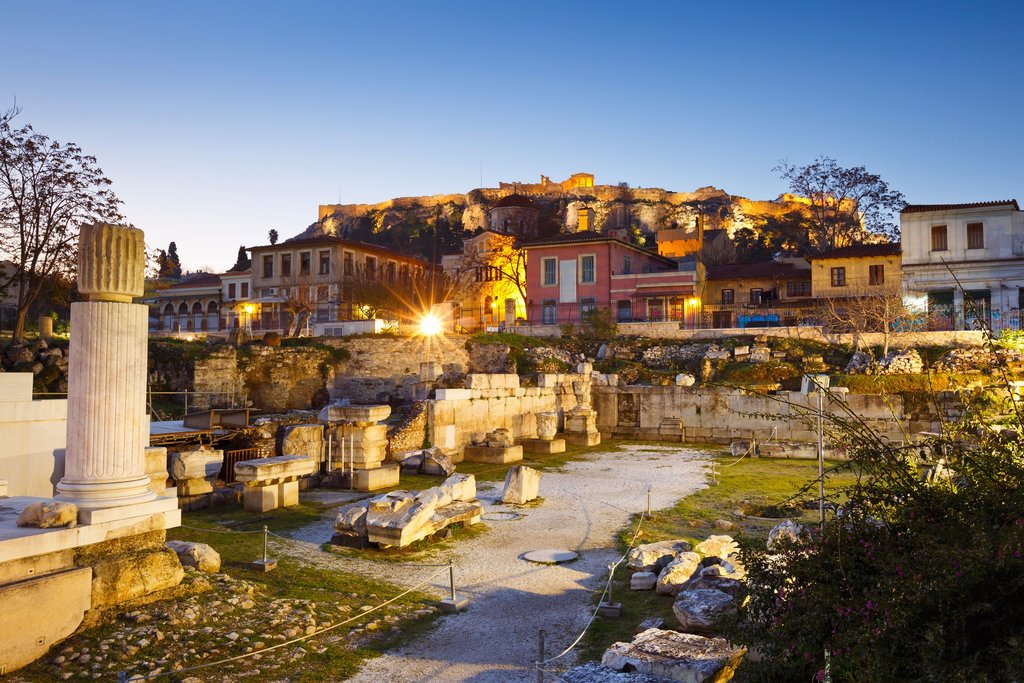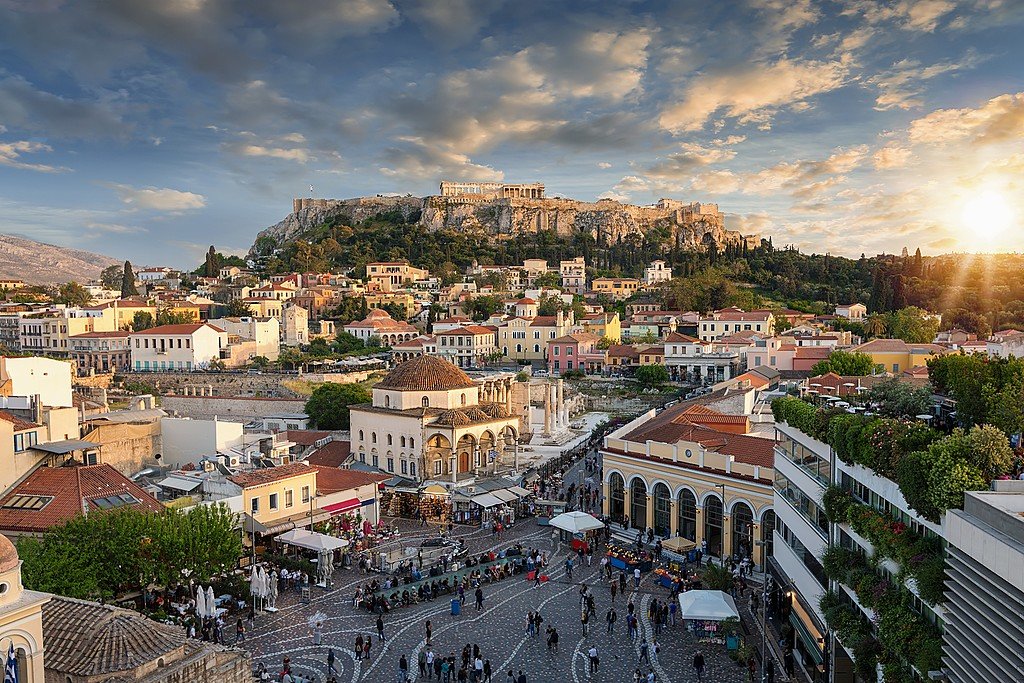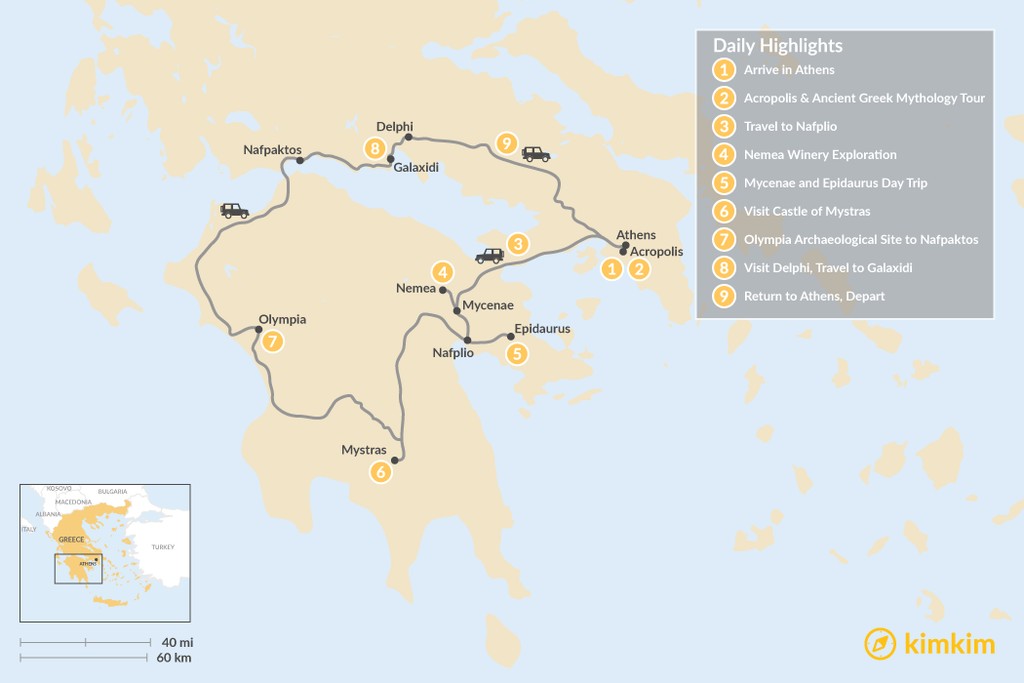
Mainland Greece Road Trip - 9 Days

Highlights
- Sample native varietals at the wineries of Nemea
- Visit archeological sites at Ancient Sparta, Olympia, and more
- Seek the oracle on a historical tour of Delphi
- Tour the castles of beautiful Mystras and Monemvasia
Brief Itinerary
| Day | Highlights | Overnight |
|---|---|---|
| Day 1 | Arrive in Athens, Welcome Dinner | Athens |
| Day 2 | Acropolis and Ancient Greek Mythology Tour | Athens |
| Day 3 | Travel to Nafplio | Nafplio |
| Day 4 | Nemea Winery Exploration | Nafplio |
| Day 5 | Mycenae and Epidaurus Day Trip | Nafplio |
| Day 6 | Castle of Mystras | Mystras |
| Day 7 | Olympia Archaeological Site to Nafpaktos | Nafpaktos |
| Day 8 | Visit Delphi, Travel to Galaxidi | Galaxidi |
| Day 9 | Return to Athens, Depart |
Detailed Itinerary
Day 1: Arrive in Athens, Welcome Dinner

Welcome to Greece! You'll begin your trip in Athens, home to both the iconic Acropolis and so much more. The mythology of this spectacular city precedes it, with towering temples to Classical deities and the ruins of ancient marketplaces rubbing shoulders with lively nightlife, crowded flea markets, and contemporary cuisine. Make the most of your time in the city at some of these spots:
- Check out the views of the can't-miss Parthenon. (Pro tip: The Parthenon is the temple, the Acropolis is the hill.) This temple to Athena has enchanted visitors since its construction was completed in 438 BC. It's probably the first thing that comes to your mind when you think of ancient Greece and is visible from many of the city's high points.
- Stop at the sprawling National Museum for a crash course in ancient iconography. Be sure to seek out the room housing the Antikythera mechanism, essentially an ancient astronomical computer.
- Visit a smaller archaeological site at the Tower of the Winds, then stroll down neighboring pedestrian Aiolou Street to stop at shops and cafes.
- Find your perfect souvenir or sun hat in the busy stalls of the Monastiraki flea market.
In the evening, you'll sit down to enjoy either a welcome dinner with views of the Acropolis or wine tasting in a bar in downtown Athens.
Day 2: Acropolis and Ancient Greek Mythology Tour

Experience the ancient stories surrounding you with today's guided mythology tour. You'll meet your guide and storyteller at the Temple of Olympian Zeus, then head to landmarks around the city including the Acropolis, ancient cemetery at Kerameikos, and the Agora. The myths that founded the city and are featured in its retellings for generations will accompany as you go, with stories of Zeus, Athena, Poseidon, Dionysus, and more. Hear both the stories themselves and the historic facts behind them, adding resonance to the archaeological ruins you will visit during this four-hour tour.
Make your way over to explore the Acropolis Museum on your own after your tour (or join a guide if you'd prefer). Named one of the ten best museums in the world by National Geographic, this modern museum houses a multitude of artifacts removed from the hill of the Acropolis for safekeeping to provide insight into ancient religious practices and daily life. Linger for lunch in the museum's cafe, with views of the artifacts' former hilltop home.
As night falls, you may be able to visit the Athens Observatory to learn about the constellations overhead and take a look through the telescope. Its hours vary seasonally and by day of the week.
Day 3: Travel to Nafplio

Today brings you to Nafplio, one of the prettiest seaport towns in the Peloponnese peninsula. Once believed to have been founded by the son of Poseidon, the town was the first capital of the new Greek state after the war of independence in the 1800s.
Take a stroll through the old town, where you'll pass statues honoring significant figures from Nafplio's history alongside Ottoman fountains, and Venetian architecture along the winding streets, topped off by the Bourtzi Castle in the middle of the harbor. Accessible only by boat, the castle was built in the 1470s to defend the city from pirates, and it still keeps watch at the entrance to Nafplio Bay.
Visit the Vasileos Konstandinou pedestrian street to take you across the old town, ending in Syntagma Square, also known as Constitution Square, where you can choose between a variety of tavernas for dinner. Don't miss the climb up 1,000 steps to see the view from the Palamidi Castle, or visit the scenic Arvanitia path along Acronafplia, which lives up to its translation of "the edge of Nafplio."
Chat with a local specialist who can help organize your trip.
Day 4: Nemea Winery Exploration

Spend your day among the wineries of Nemea, one of the country's most important wine-producing areas. They're especially known for their Agiorgitiko wine, believed to have been first grown from a vine brought by the god Dionysus. These grapes, which are similar to Merlot, are considered to be one of the finest Greek red varietals and have grown in the region for thousands of years—possibly since the 4th century BC. The ancient red wine called Fliasion was also believed to be produced in this area.
You'll visit three wineries to observe the wine-making process and stroll through the vineyards. And, of course, sample the varietals along the way, along with a lunch of local cuisine with wine pairings at one of the stops.
If you find yourself fondly remembering any particular bottles later that you wish you'd purchased, the local cooperative also operates an outlet where many of the wines are available.
Day 5: Mycenae and Epidaurus Day Trip

Travel back in time to the well-preserved archaeological sites of Epidaurus and Mycenae, both deserving of their UNESCO World Heritage Site status.
You may recognize Mycenae from its role in Homer's Iliad: It was home to the famous Helen, whose Mycenean husband Agamemnon led his people to war when she left him for Paris of Troy. See its Cyclopean walls, whose construction method is still a mystery. They got their name due in part to the belief that only the mythical Cyclops would have been strong enough to lift their boulders. You'll pass through the Lion Gate to enter the ruins of the city, wandering past the tombs of Aegisthus and Clytaemnestra and the Treasury of Atreus. Don't skip the onsite museum, full of artifacts of everyday life in the city.
Next, you'll visit the small ancient city of Epidaurus, which was one of the most visited healing centers in the world during its peak. The sick would travel to the Sanctuary of Asklepios, the god of medicine and healing. They would spend the night in the temple's sleeping hall in hopes that the deity would appear in the dreams with a diagnosis and cure for their condition, whatever it may have been.
You'll also see the city's third-century theater, one of the best remaining examples of its type due to the excellent acoustics and aesthetic arrangement. It was originally designed for musical and singing competitions, and is the largest stone resonator in the world. Aeschylus, Sophocles, and Euripides all had plays performed here.
Depending on the timing of your trip, you may be able to catch a performance on the ancient stage.
Day 6: Castle of Mystras

Today, you'll embark on an expedition over the slopes of Mount Taygetos to the Byzantine citadel of Mystras. This fortified town in Morea was built as an amphitheater around a fortress erected in 1249 by the prince of Achaia, William of Villehardouin. It was conquered by the Byzantines, Turks, and Venetians over its history before the city was abandoned in 1832.
The medieval ruins are still standing and ready for you to explore, complete with UNESCO World Heritage Site designation. Its three zones now represent different eras in its history: the Upper City and Despot's Palaces, Lower City and Metropolis, and Outer City. You'll want to spend at least three hours hiking around the steep hillside.
Day 7: Olympia Archaeological Site to Nafpaktos

Explore the site of the first Olympic Games at the archaeological site of Olympia. There's plenty to cover—it's one of the largest sites in the country, surrounded by wild olives and plane trees. Your comprehensive guided tour will take you under the grand temple columns, past the Sanctuary of Olympian Zeus and through the onsite Archaeological Museum.
There will also be free time after the tour to explore the site on your own. Scope out the treasuries, sacrificial altars, and stadium once used by the ancient world's best athletes. The natural landscape surrounding the site is also full of opportunities for a day hike if you'd like to put your muscles to use.
Once you've completed your explorations, head north over the Rio-Antirrio Bridge across the Gulf of Corinth—one of the world's longest multi-span cable-stayed bridges. You'll spend the night in Nafpaktos overlooking the waters of the gulf and the town's castle. Spend your evening exploring the town's charming streets.
Day 8: Visit Delphi, Travel to Galaxidi

Seek out the oracle as you continue to the ruins of Delphi, once home to priestesses of Apollo who Ancient Greeks believed could predict the future. You'll take a guided tour through this sprawling archaeological site, with stops such as the Treasury of the Athenians, the Temple of Apollo, and expansive theater.
Explore the ruins or venture up an ancient footpath once used by worshippers of the god Pan, who started from the temples of Delphi and proceeded to Corycean Grotto for their religious rites, surrounded by the valley of olive trees and views of the Corinthian Gulf and peaks of the Peloponnese on your way.
Head indoors to explore the museum, a short downhill walk away. Wander through its halls to find the bronze Charioteer of Delphi, marble Sphinx of Naxos, and what may be the first recorded notation of a melody once inscribed on the walls of the Athenian Treasury.
You'll stop at the popular mountain resort town of Arachova at the foot of Mount Parnassus for lunch, including grilled formaella cheese, amidst the traditional stone-built houses. Then continue onward to Galaxidi, your destination for the evening. Wander among the neoclassical houses and two small ports to find your ideal dinner spot.
Day 9: Return to Athens, Depart

Time to say farewell to Greece. You'll head back to Athens after breakfast to catch your flight, either home or onward to your next adventure.
